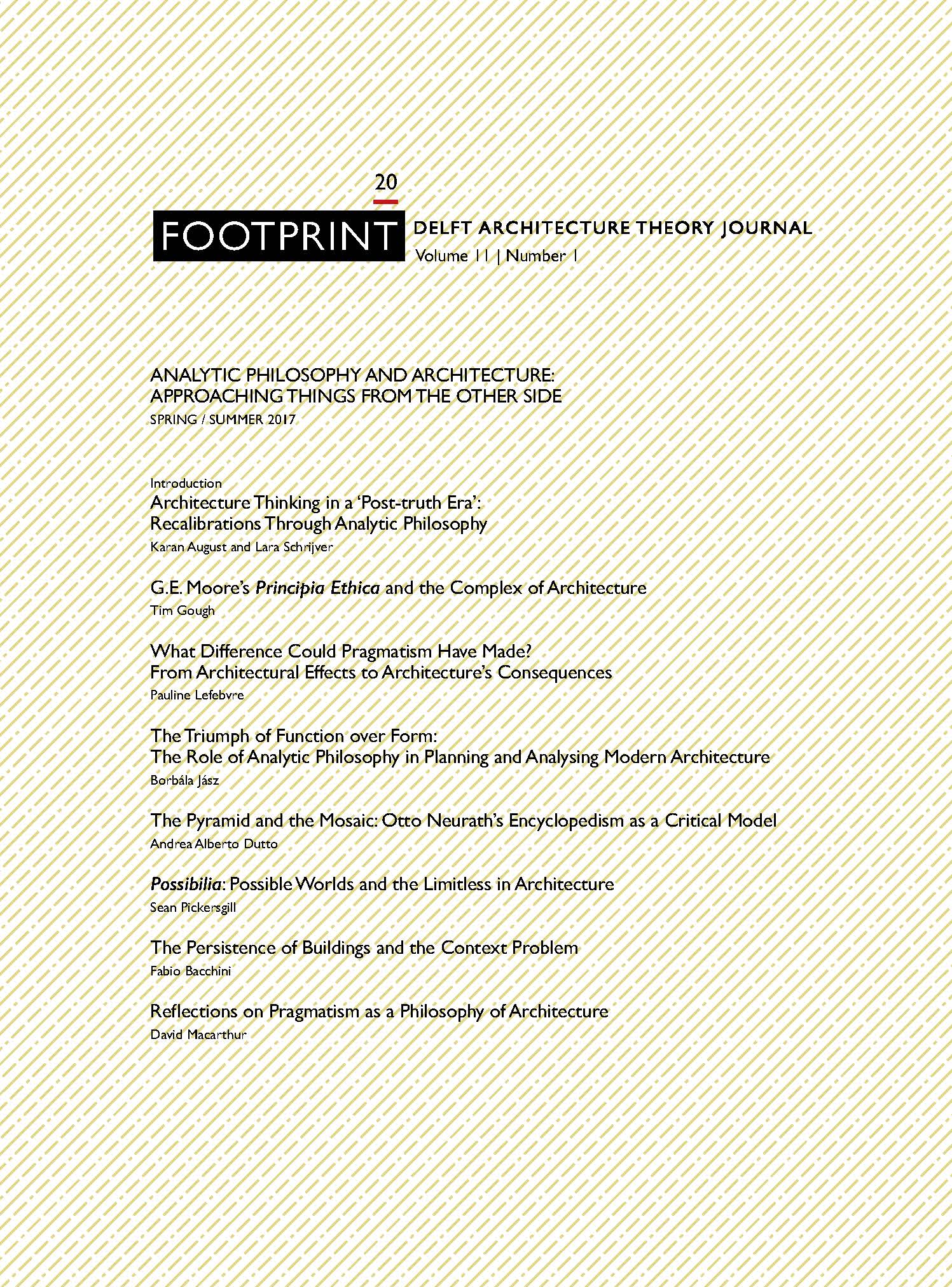The Persistence of Buildings and the Context Problem
DOI:
https://doi.org/10.7480/footprint.11.1.1188Abstract
Raising the persistence question about architectural entities consists in asking what is necessary and sufficient for a past or future architectural entity, like a building, to exist now. In this paper I investigate how the persistence question about buildings is affected by their spatial relocation. Why do we normally doubt that Notre Dame can survive its meticulous stone-by-stone transfer to Las Vegas? I argue that, since architectural plans are not capable of specifying all the constitutive properties of a building, the source of differentiation among constitutive and non-constitutive properties for buildings lies in a property’s being eligible or not eligible to be aesthetically relevant in the aesthetic judgements about them. As a matter of fact, our aesthetic judgements about buildings often concern, and are grounded on, extrinsic contextual properties. This explains why buildings can usually not survive relocation: because normally there is no basis for ruling out any extrinsic contextual feature of the building as inessential. I also try to explain why the change from thirteenth century Paris to contemporary Paris proved not to be lethal to Notre Dame’s persistence, in spite of its being more significant than other imaginary context changes that we would easily count as fatal.
References
Dennett, Daniel C. “Conditions of Personhood.” In The Identities of Persons, edited by Amelie O. Rorty, 175-196. Berkeley and Los Angeles: University of California Press, 1976. Reprinted in his Brainstorms. Montgomery, VT: Bradford Books, 1978.
Dennett, Daniel C. Consciousness Explained. Boston: Little, Brown & Company, 1981.
Fine, Kit. “The Non-identity of a Material Thing and Its Matter.” Mind 112 (2003): 195–234.
Fisher, Saul. “Philosophy of Architecture.” In The Stanford Encyclopedia of Philosophy (Fall 2015 Edition), edited by Edward N. Zalta, accessed May 13, 2016, http://plato.stanford.edu/archives/fall2015/entries/architecture/
Goodman, Nelson. Languages of Art. Indianapolis: Bobbs-Merrill, 1968.
Lopes, Dominic McIver. “Shikinen Sengu and the Ontology of Architecture in Japan.” Journal of Aesthetics and Art Criticism 65, 1 (2007): 77-84.
Merricks, Trenton. Objects and Persons. Oxford: Oxford University Press, 2001.
Nagel, Thomas. The View from Nowhere. New York: Oxford University Press, 1986.
Nozick, Robert. Philosophical Explanations. Cambridge, MA: Harvard University Press, 1981.
Olson, Eric T.. “Personal Identity.” In The Stanford Encyclopedia of Philosophy (Spring 2016 Edition), edited by Edward N. Zalta, accessed May 13, 2016, http://plato.stanford.edu/archives/spr2016/entries/identity-personal/
Parfit, Derek. Reasons and Persons. Oxford: Oxford University Press, 1984.
Sider, Theodore. Four Dimensionalism. Oxford: Oxford University Press, 2003.
Shoemaker, Sydney. “Personal Identity: A Materialist's Account.” In Personal Identity, edited by Sydney Shoemaker and Richard Swinburne, 67-132. Oxford: Blackwell, 1984.
Strawson, Galen. Selves: An Essay in Revisionary Metaphysics. Oxford: Oxford University Press, 2009.
van Inwagen, Peter. Material Beings. Ithaca: Cornell University Press, 1990.
Williams, Bernard. “Personal Identity and Individuation.” Proceedings of the Aristotelian Society 57 (1956-1957): 229-252. Reprinted in his Problems of the Self. Cambridge: Cambridge University Press, 1973.
Downloads
Published
Issue
Section
License
- Authors retain copyright and grant the journal right of first publication with the work simultaneously licensed under a Creative Commons Attribution License that allows others to share the work with an acknowledgement of the work's authorship and initial publication in this journal.
- Authors are able to enter into separate, additional contractual arrangements for the non-exclusive distribution of the journal's published version of the work (e.g., post it to an institutional repository or publish it in a book), with an acknowledgement of its initial publication in this journal.





